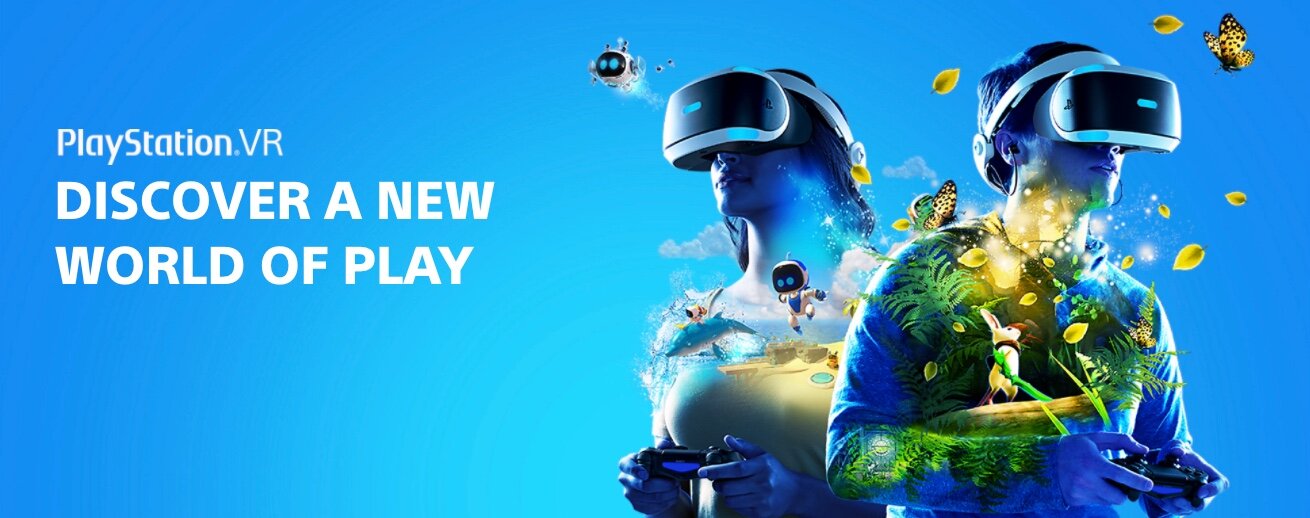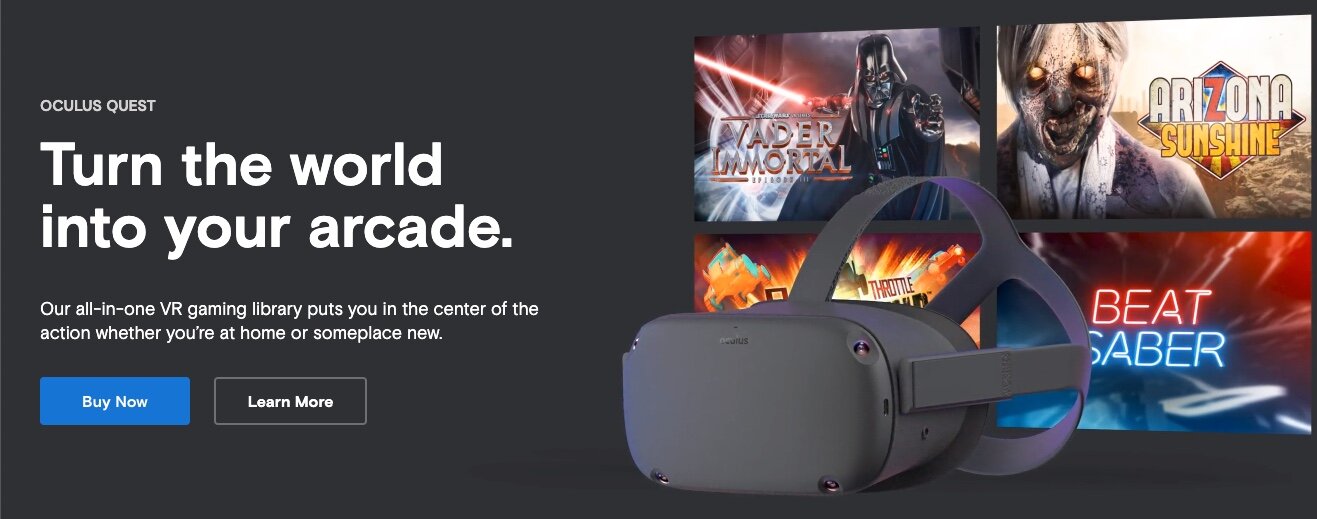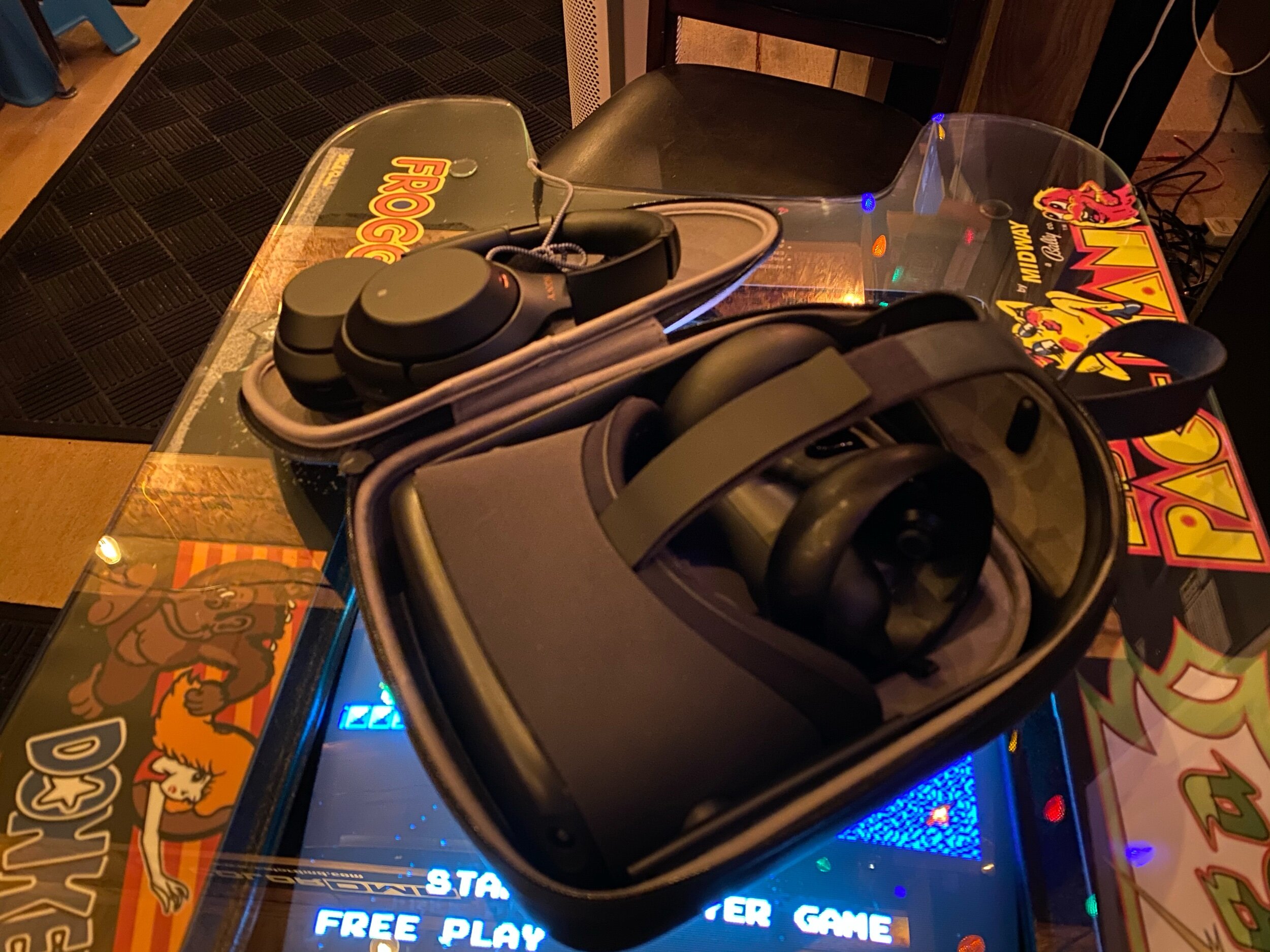The other day, my son was playing Rec Room on PSVR when I heard a high pitched youth voice crackle through the den speakers “Man, I wouldn’t ban you, you are my BEST FRIEND!” Let me be clear, I have no idea who he was playing with but I guarantee it wasn’t someone he actually has met IRL.
As my kids try out Virtual School, I found myself wishing Virtual School operated a little closer to what was described in Ready Player One (the book). The kids get settled in a place with comfortable temperature and stable power and pull on their school-issue headsets. From here they are jacked into an instance of an educational planetoid: Ludus, where the main character attends OASIS Public School #1873. Their avatars are seated together in a virtual classroom. The teachers aren’t bound by physical limits and can transport the classroom to approximations of ancient battlefields or star-maps of far-away galaxies for study. The kids inhabiting these avatars have at their disposal a compendium of human knowledge and entertainment. Ironically, a world-class education that in their society does nothing for providing opportunities for advancement.
Okay, so maybe that last part is a little too real.
Instead of Über-engaging and mind-expanding lessons pinball’ing through space and time our kids lessons are more mundane. Link-lists of assignments with supported material coming from a disjointed cluster of sources from old-school publishers using technologies like PDF and browser-based Flash. (Which will soon be disabled.) Their classrooms are more like the Brady-Bunch tile screen that have become a hallmark of Pandemic 2020 than the shared virtual experience outlined in Ernest Cline’s vision for virtual education in the future.
Plenty Of: 401 Unauthorized - Please login again
and
Not Enough: Neo-Goonies adventures with virtual classmates after class.
At least the fully-dystopian collapse of society as depicted in Ready Player One hasn’t come to pass. Yet. (2020!)
If you are reading this, odds are you are in my target demographic of “nostalgia nerd” and I thought it might be fruitful to take a few minutes to look at where we are in terms of Virtual Reality.
First, some terminology.
Virtual Reality (VR) - Headsets, technologies & experiences that put the player into a virtual environment. Think: Lawnmower Man but not necessarily with the seizure inducing fractals.
Augmented Reality (AR) - Handheld displays, headsets, technologies that present a virtual objects into a real environment. A simple smartphone example would be Pokemon Go!, a simple standalone example might be the Terminator HUD or Google Glass. A more complex example is Microsoft HoloLens.
Augmented Reality
It seems like Augmented Reality is a technology in search of a problem to solve. Mostly you see AR being used from a smartphone for gaming (Pokemon Go!) or novel uses around use-cases like “will this dresser look good in my bedroom?” where they digitally paint and object with spacial awareness into your camera view.
Google Glass used AR (of sorts) to give you a personal Heads Up Display but at the expense of turning everyone into cybernet photographers. Many people on the other end of that head-mounted camera found it off-putting. Glass-holes became a term to describe it.
Apple has plans to dip into AR and maybe even VR hardware later this year or early next year if patents and rumors are to be believed.
Microsoft’s HoloLens might have been one of the most ambitious visions for a future inclusive of AR technologies
But mostly, AR is relegated to the “a neat idea” without a ton of practical implementation. I’m sure somewhere there may be high-tech rocket engineers collaborating in real-time with their engineer counterparts across the globe via a shared AR experience but mostly, to date, AR’s greatest contribution has been towards solving problems for VR.
Virtual Reality
The explosion of VR in the last 8 years was partly driven by improvements in spacial sensor tech used in smartphones. Gyroscopes, accelerometers and inexpensive imaging sensors used in smartphones were the breakthrough components to solve the VR Head tracking problem. The basic principle of modern VR is that you could strap a cellphone to your face with blinders on the corners and two lenses. Head tracking maps your head movements into look-controls on the display. The effect is that as you look around the VR image changes 1:1 with your head movement. The ability to naturally look around gives you the feeling of immersion.
The major players in VR right now are Oculus, HTC Vive & PSVR.
(plus a bunch of cardboard and plastic phone-based things I’ll discuss in a minute)
HTC VIVE
For awhile the HTC VIVE had a solid head start for serious VR experiences and gaming. The VIVE headsets require a VR-ready gaming PC though they offer some choices for wireless connectivity. Most VIVE editions handle tracking through the use of triangulation towers in the room, which makes setup and portability take longer than other VR headsets. (Though, the Cosmos now supports the “multiple cameras on your faceplate” method for headtracking similar to Oculus. )
The headsets and controllers are on the top end of the market but they also hold up incredibly well. Several commercial-use VR lounges that I’ve been to use VIVE Hardware. For games and VR Experiences VIVE owners are mostly going to stick with SteamVR library games, I believe VALVE even had a hand in developing their tracking technology.
Vive Cosmos By The Numbers
Dual 3.4” diagonal display
1440 x 1700 pixels per eye (2880 x 1700 pixels combined) @ 90hz
110° field of view
Price: $699 / $899
PSVR
When Sony launched PSVR, I’ll admit that I was skeptical. I think flashbacks of the letdown in expectations that were set by Nintendo Virtual Boy Commercials back in the 1990’s may have colored by expectations in crimson.
Never fear Console-based VR Enthusiasts, the PSVR is a pretty solid value and includes a nice game list. Most multi-platform games will come to Steam or Oculus before PSVR but that also means you aren’t actively testing out beta software for the game developer by the time it lands on your console.
For head tracking, the PSVR uses a single camera mounted on or near your TV and clever lights that help the camera to calculate head position and controller locations.
I appreciate that the PS4 has enough horsepower to drive the PSVR and the primary HDMI at the same time. This makes possible some party / social VR gaming with games like Beat Saber.
That way, your friends will know what you look like when you walk through a spider-web.
There are two revisions (currently) of the PSVR headset. They look more or less the same but the newer Rev moves the On / Off & Volume controls from a pack on the cords to the headset itself. It was a quiet but useful improvement; makes the cables less prone to tangle. Sony claims that you will be able to use PSVR with the PS5, though it may require an adapter. I’d be surprised if they didn’t eventually make a PS5-specific upgraded version of the headset.
The resolution is lower on the PSVR than you might get from a PC-Driven headset but not to the point of being detrimental on most games. The PSVR headset padding (Forehead & Head Strap) are made of a very soft foam-rubber. I’ve found the original pads aren’t resilient to light cleaning. We tend to lysol and wipe down the pads between players. They also aren’t resilient to buzz-cut haircuts on the head strap. Being a bald guy, I’ve noticed a 2-day head stubble will act like sandpaper to that foam rubber. Sony doesn’t have a great solution for replacing these pads, either. It can be done but I had to call them… on the phone… like a savage.
GAMES
You get PSVR games at the Playstation Store, alongside other Playstation games.
Star Wars: Battlefront (I) included a free add-on VR Mission that was absolutely incredible. Star Tours at Disney World level of Incredible. Unfortunately, they only ever created the one mission. Even with the single mission being able to fly an X-Wing in VR was worth the price of admission to PSVR, for me anyway. Remember, I built the dome thing so I’m slightly obsessed with this concept.
Star Wars: Squadrons, releasing October 2nd, 2020 might finally answer the need for more space battles in VR.
Call of Duty: Infinite Warfare wasn’t a great game IMO but it didn’t include the Jackal Assault VR Experience, another single-mission space-based battle sim.
SuperHot VR is a neat take on a Matrix-y bullet-time gun and fist game. It is cartoony but still visceral at times. Parents, be warmed though: One portion of the game encourages the player to shoot themselves in the virtual head to show their allegiance and escape the simulation.
Beat Saber came late to PSVR but they took the time to get it right. The PSVR is especially good at Beat Saber b/c the motion controllers feel like light-saber hilts, because most PS4s are hooked to a thumping home audio system and b/c the two-screen experience makes it a good party experience.
Other PSVR games of note include Pistol Whip, Thumper, Rec Room, Vacation Simulator, Job Simulator, Battle Wake, Ace Combat 7, Arizona Sunshine, Everybody’s Golf VR, Vader Immortal. The Sony PSVR catalog has grown nicely over the last few years.
PSVR By The Numbers
Single 5.7” panel
960 x 1080 pixels per eye (1920 x 1080 combined) switchable between 120hz & 90hz
~100° field of view
Price: $349
Oculus Rift
Oculus was acquired in 2014 by Facebook. I think it is called Facebook Labs now? At any rate, I have complicated and mixed emotions regarding Facebook but I’m pretty clear-eyed where John Carmack is concerned. As a developer, I see him as a legend and some of his work and philosophy resonates with me.
My first experience with Oculus was in 2013, I tried to use a DK1 (Oculus Dev Kit) with a Drone for FPV (First-Person-View) Controls. At the time, my experience was that the amount of time it took to process the dual FPV camera feeds into a single VR-Ready video stream was too high to be applicable to fast-pace flight. Such a lag slows down effective reaction time too much. I was impressed with the build quality of the DK1 but promptly passed it on to someone that to could it more … appropriately.
Late last year, I started looking at VR solutions that might be compatible with one of the PC gaming platforms like Steam. I really didn’t want to install light towers or position cubes in the room. I was also hesitant to go with something that might require me to build out a full gaming PC. I didn’t want to get pulled into “Daaaaaaaddddd, the VR PC is asking for updates again, what do I do?” family tech-support tasks. Even though it doesn’t natively support Steam, I was seeing a decent cadence of games porting to Oculus Quest. The largest appeal being the Oculus Quest doesn’t require an external PC in order to operate.
Oculus Quest & Sony WH-1000XM3’s
Out of the box, I was impressed with the build-quality of the Oculus Quest. The materials seem to be a good bit more resilient and modular than those of the PSVR. It is a lot like the build-quality of the Vive, actually. It seems as though a light-cleaning with alcohol wipes or lysol between players or a stubbly head won’t destroy the straps.
As mentioned earlier, the Oculus Quest is unique in that it doesn’t require connections of any kind, to anything. It is fully wireless which is incredibly freeing. Understand though the trade off of being fully wireless is there is more weight in the headset for battery and phone-like internals.
SETUP
Head tracking on the Oculus quest moves the (4!) cameras to the headset itself. Four of them provide what is called an inside-out head tracking experience. No light or position towers, everything is right inside the headset. The brilliance of this is that you can take the headset into any room and play. The headset detects when you are in a new room and keeps track of play areas that you define. It is really quite ingenious. While wearing the headset, it detects that you are in a new room and the display shows you a Terminator-vision Augmented Reality view of the room. You use the controller to draw a boundary and set the floor height and the Oculus saves these as room profiles it calls Guardians.
It seems like a lot of thought went into the UI here (and throughout) to make the Oculus Quest a very intuitive experience. The blend of AR and VR for boundary-keeping and notifying a player of objects in the boundary is very good and sensitivity is configurable for those trying to play in a tight space.
SOUND
The Oculus Quest differentiates itself in the sound department. It includes a set of speakers that directionally fire sound into your ear holes. The effect is sort of like when you take off over the ear headphones and wear them around your neck but keep playing the music. It is good enough for casual play but no so loud to be distracting to everyone in your household. The Quest also has headphone jacks for in ear or over the ear headphones. It supports bluetooth audio as well but the experience is laggy.
GAMES
You get Oculus Quest games via the Oculus Store. Some of the same popular titles as the PSVR, including Beat Saber, Rec Room, SuperHot and Job Simulator.
Oculus gained an exclusive upfront deal on Vader Immortal before it came to the PSVR in May 2020.
I enjoy playing Pistol Whip, a techno-music scored John Wick conveyor-belt shooting gallery.
With bowling alley’s being shut down I’ve found Premium Bowling to be good fun. It has decent hook physics and supports a pretty neat multiplayer experience.
VR EXPERIENCES
The Quest has a solid offering of VR Experiences through a variety of curated sources (Youtube 360, Amazon and many others) which makes it an incredible value for exploration entertainment. Whether you want to see the perspective of the rear seat of a Blue Angel or float down an a River passage on the Amazon, Fly above the ground on a WingSuit or check out a new rollercoaster; there is a lot to do and see.
Parents Note: Most things on the internet only takes a few clicks to find Porn. It was important to me that my kids not stumble onto this stuff accidentally. Later, when they go looking for it… well, that is a problem for another time. I’m appreciative that the VR experiences that I’ve seen on the Oculus Quest seem to be pretty well curated. There is language and violence in some instances but nothing overtly pornographic that I’ve stumbled upon.
Be warned though as the Quest opens up for certain web browsers with native WebVR support this may change and bring easier accidental adult discoveries on the platform.or.. if you are a grown-up looking for that - WebVR is the key technology to allow less-curated content to play on the Oculus Quest.
PEAKING OVER THE WALLS OF THE OCULUS WALLED GARDEN
Oculus released a USB-C based fiber optic cable and supporting software called Oculus Link allowing the Quest to be connected to a VR Ready PC. So you get the capabilities of the original Oculus Rift and Oculus Rift S along with the Quest built in features.
Using an i7-based Dell XPS8930 w/ 32 gb of RAM, a 1tb SSD and GTX 1080 (8gb) video card with the Quest, I’ve been able to play pretty much any SteamVR content that I’ve tried.
VIRTUAL PINBALL
One of the reasons I was looking to expand towards the PC-VR space was to be able to play Pinball in VR. The Oculus Store for Quest has Pinball FX2 in VR, which includes some of FX2’s fantasy tables that are often knockoffs or riffs of popular pinball classics. PinballFX2 is to real pinball what Spinner Hubcaps are to Rims. (There, I said it.) All flash and no substance.
With the full back catalog of Bally / Williams tables on The Pinball Arcade on Steam, I was hoping the introduction of a VR headset would allow me to play those games in VR.
None of that worked. I guess Farsight’s efforts to support VR are limited to the Stern Pinball Arcade. I’ll have to continue to research to find a way to get Bally - Williams tables working with VR. It looks like there may be options with more steps and kludgy freeware but I was hoping for the decent physics in The Pinball Arcade..
finding out my $$$ spend in Bally-Williams tables doesn’t translate to VR..
Using Oculus Link I was able to play Stern Pinball Arcade on the Quest. Stern & Farsight’s joint venture currently offers the following tables:
Ghostbusters
Harley Davidson
High Roller Casino
Last Action Hero
Mustang
Phantom of the Opera
Ripley’s Believe It or Not!
Starship Troopers
Star Trek
SAMPLE GAMEPLAY
If you have your barf-bag ready, feel free to venture into one of the videos below. These are captures from VR gameplay in Stern Pinball Arcade.
Interestingly enough, 4 months ago I could play AC/DC but it now says the game is no longer available. Their license expired, I believe. No new games have been added in that time. This makes Stern Pinball Arcade feel a little stale.
Stern Pinball Arcade Pros and Cons
Pros
Extremely Good Recreations of Stern Tables
Realistic physics compared to the real thing
Good Leaderboards
Good variety in types of Stern games
Cons
Stern-Only
Clunky Menu
Overly complicated in-app purchase terminology
Many 1-Star Reviews (people reporting issues)
No new tables in awhile (abandonware?)
Sometimes lags
VIRTUAL ARCADE
Continuing with the theme of stretching the Oculus Quest beyond its original limitations, I’ve also seen videos of people managing the Side Load Oculus Arcade (original from the GEAR and GO hardware) onto the Oculus Quest
Even though my VR Arcade and Pinball side-goals with the Quest have had some roadblocks, I’m seriously impressed with the Oculus Quest. It is a well done, integrated and well-designed piece of equipment and related software. The biggest downside I see with the Quest as compared to a VR headset that more naturally connects to your home entertainment setup is that it is generally a solitary experience. We play PSVR at parties, not Oculus.
Oculus Quest By The Numbers
Single OLED ~5.5” panel
1440 x 1600 pixels per eye (2880 x 1600 combined) @ 72hz
~95° field of view
Qualcomm Snapdragon 835 8 Core
4 Kryo 280 Gold (ARM Cortex-A73 based) @ 2.45 GHz
4 Kryo 280 Silver (ARM Cortex-A73 based) @ 1.9 GHz
4gb of RAM
64 or 128gb of Storage
Price: $399/ $499
Cardboard & Milk Cartoons Strapped to Your FaCe vs LASERS in YOUR EYE
As alluded to earlier the real breakthrough in VR was the smartphone. Awesome screen, check. Lots of sensors, check. Strap it to your face and sock off your peripheral and you’ve made a VR Goggle. Samsung has some cheap ones made out of plastic, Nintendo has one made out of cardboard. I’ve seen home-brews made from egg crates and milk cartons.
Everywhere you look there is another 2nd or 3rd class-citizen in the VR offering landscape. Ultimately, the thing that will make or break a given VR platform is going to be content. In the beginning of this I talked about Ready Player One; in the book the breakthrough that allowed for the mass adoption of OASIS was the company’s breakthrough retinal-projection technology.
The HTC VIVE was a generational leap over its predecessors and the Oculus Quest is another generational hop in the right direction.
Ultimately, VR is going to look more like the Oculus Quest than the PSVR within the next decade. Wires & dependence on a kludge of loosely connected software running on a nearby computer will give way to smaller, more powerful (and portable) innovations. The software developers will follow these hardware innovators and ultimately only a few clear winners will emerge.
As John Carmack and his son head home to work on Artificial General Intelligence, I hope the team left behind at Oculus continues to innovate and push the envelope, staying clear of Facebook’s tendencies to step in it with Washington, with consumers, with advertisers and with their employees.
Update: Oculus Quest 2
About a week after I posted this, Oculus updated its VR model lineup and introduced the Oculus Quest 2. The Quest 2 will replace the Quest 1 (Quest 1 no longer produced but still supported) and the Oculus Go and Oculus S are both going away in favor of the Quest 2. For a more in-depth look at the Quest 2, here is a review I found very helpful (below).









